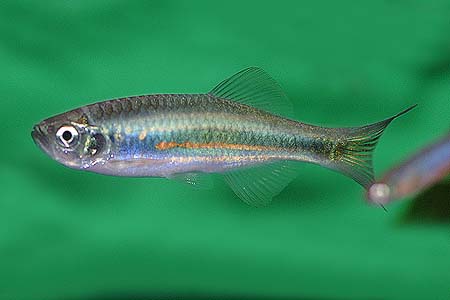Danio - Giant
Scientific Name: Danio aequipinnatus
Thu, 3rd July, 2025 - 10:25 am GMT
Sponsor Ads:

Alternative Name
Scientific Name: Danio aequipinnatusBasic Info
The Great Danio will reach a maximum size of four to four and a half inches. They have blue lines down their body. A male's line will go strait to the end of the tail fin, while a female's blue line will bend upward at the tail. Also, the males tend to be slimmer and brighter than the females.
Health
Specific Care Information: Relative Care Ease: Uncertain While relatively hardy, the Great Danio has a narrow inhabitable temperature range. This range is 72 to 75 degrees Fahrenheit. They do best in slightly acid, or neutral water, with a pH ranging from six to eight. They also prefer elongated tanks. They are an omnivorous fish, their diet can consist of the usual fish foods: live blood worms, glass worms, brine shrimp, tubifex worms, as well as frozen vegetables, daphnia, mosquito larvae, brine shrimp, and plankton. The Great Danio will also eat flake and freeze dried foods. The Giant Danio is known as a jumper, so it is very important to cover your tank with a tight fitting lid. Breeding The Giant Danio is not difficult to breed in captivity. The breeding tank should be long with bushy plants covering the bottom. The purpose of the plants is to prevent the parents from eating the eggs. The Great Danios are egg scatterers. A typical spawn will consist of roughly 300 eggs. It is generally recommended that the parents be removed after eggs are laid. The eggs will hatch in about 30 hours. The fry are easy to raise.Habitat
Fresh water fish - Their habitat should be decorated moderately with live plants, driftwood, and rocks.Behavior
The Giant Diano, or Danio aequipinnatus, is a great community fish. It will actively school with other fish of the same size. They also are known for their ability to jump, so they should be kept in a covered aquarium, or they might jump out. They are especially useful for cycling new aquariums, as they will do well in water with high levels of nitrate and ammonia nitrate. There are several long-finned varieties, which are very beautiful as well. Being such an extremely active fish, the Great Danio is known to unnerve other, more docile fish. They become powerful jumpers when they mature, which can make for an interesting show. Great Danios should be kept in schools, as they are a social fish. They are not overly aggressive. Three to five Danios can be kept in a minimum of 10 gallons. Be warned, however, the Great Danio might nip on live plants.Origin
Sri LankaHistory
Giant Danios originate form Southwestern Asian countries, including: India, Nepal, Bangladesh, Myanmar, Thailand Sri Lanka, Bhutan and China. They are found in hill streams under 300 feet of elevation. In the wild, they will be located in clear, shady water with gravel or pebble substrates. Also, Great Danios are always found in schools in the wild. They are not widely available in markets, but they are popular in the aquarium trade.Common Foods
N/ASponsor Ads:
"Walk in the path defined by rule, and accommodate yourself to the enemy until you can fight a decisive battle." -- Sun Tzu, The Art of War
Danio - Giant
Coded by: BGID® | ALL RIGHTS RESERVED Copyright © 2000-2025
Disclaimer | Privacy | Report Errors / Contact | Credits








 Why haven't we as a collective earth met with aliens yet?
Why haven't we as a collective earth met with aliens yet?  World EcoSystem - Biodiversity Changes - Who is on board and who isn
World EcoSystem - Biodiversity Changes - Who is on board and who isn  Homosexual behavior stems from the mind or genetics?
Homosexual behavior stems from the mind or genetics?  The Best Text Adventure You Will Ever Play! The official site:
The Best Text Adventure You Will Ever Play! The official site:  Mouthwash - Mouthrinse - Mouth Sores - Healing Infections - Gingivitis
Mouthwash - Mouthrinse - Mouth Sores - Healing Infections - Gingivitis  Treatment for Depression
Treatment for Depression  Ultra radical and violent Islamist group that even rivals Al Qaeda
Ultra radical and violent Islamist group that even rivals Al Qaeda  An idea to have teachers who want to carry guns to school undergo some level of police training will be left up to local school districts and police departments.
An idea to have teachers who want to carry guns to school undergo some level of police training will be left up to local school districts and police departments.